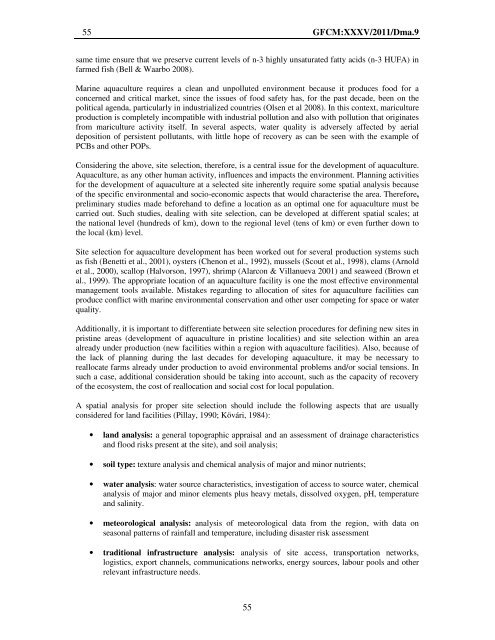Site selection and carrying capacity in Mediterranean ... - FAO Sipam
Site selection and carrying capacity in Mediterranean ... - FAO Sipam
Site selection and carrying capacity in Mediterranean ... - FAO Sipam
Create successful ePaper yourself
Turn your PDF publications into a flip-book with our unique Google optimized e-Paper software.
55 GFCM:XXXV/2011/Dma.9<br />
same time ensure that we preserve current levels of n-3 highly unsaturated fatty acids (n-3 HUFA) <strong>in</strong><br />
farmed fish (Bell & Waarbo 2008).<br />
Mar<strong>in</strong>e aquaculture requires a clean <strong>and</strong> unpolluted environment because it produces food for a<br />
concerned <strong>and</strong> critical market, s<strong>in</strong>ce the issues of food safety has, for the past decade, been on the<br />
political agenda, particularly <strong>in</strong> <strong>in</strong>dustrialized countries (Olsen et al 2008). In this context, mariculture<br />
production is completely <strong>in</strong>compatible with <strong>in</strong>dustrial pollution <strong>and</strong> also with pollution that orig<strong>in</strong>ates<br />
from mariculture activity itself. In several aspects, water quality is adversely affected by aerial<br />
deposition of persistent pollutants, with little hope of recovery as can be seen with the example of<br />
PCBs <strong>and</strong> other POPs.<br />
Consider<strong>in</strong>g the above, site <strong>selection</strong>, therefore, is a central issue for the development of aquaculture.<br />
Aquaculture, as any other human activity, <strong>in</strong>fluences <strong>and</strong> impacts the environment. Plann<strong>in</strong>g activities<br />
for the development of aquaculture at a selected site <strong>in</strong>herently require some spatial analysis because<br />
of the specific environmental <strong>and</strong> socio-economic aspects that would characterise the area. Therefore,<br />
prelim<strong>in</strong>ary studies made beforeh<strong>and</strong> to def<strong>in</strong>e a location as an optimal one for aquaculture must be<br />
carried out. Such studies, deal<strong>in</strong>g with site <strong>selection</strong>, can be developed at different spatial scales; at<br />
the national level (hundreds of km), down to the regional level (tens of km) or even further down to<br />
the local (km) level.<br />
<strong>Site</strong> <strong>selection</strong> for aquaculture development has been worked out for several production systems such<br />
as fish (Benetti et al., 2001), oysters (Chenon et al., 1992), mussels (Scout et al., 1998), clams (Arnold<br />
et al., 2000), scallop (Halvorson, 1997), shrimp (Alarcon & Villanueva 2001) <strong>and</strong> seaweed (Brown et<br />
al., 1999). The appropriate location of an aquaculture facility is one the most effective environmental<br />
management tools available. Mistakes regard<strong>in</strong>g to allocation of sites for aquaculture facilities can<br />
produce conflict with mar<strong>in</strong>e environmental conservation <strong>and</strong> other user compet<strong>in</strong>g for space or water<br />
quality.<br />
Additionally, it is important to differentiate between site <strong>selection</strong> procedures for def<strong>in</strong><strong>in</strong>g new sites <strong>in</strong><br />
prist<strong>in</strong>e areas (development of aquaculture <strong>in</strong> prist<strong>in</strong>e localities) <strong>and</strong> site <strong>selection</strong> with<strong>in</strong> an area<br />
already under production (new facilities with<strong>in</strong> a region with aquaculture facilities). Also, because of<br />
the lack of plann<strong>in</strong>g dur<strong>in</strong>g the last decades for develop<strong>in</strong>g aquaculture, it may be necessary to<br />
reallocate farms already under production to avoid environmental problems <strong>and</strong>/or social tensions. In<br />
such a case, additional consideration should be tak<strong>in</strong>g <strong>in</strong>to account, such as the <strong>capacity</strong> of recovery<br />
of the ecosystem, the cost of reallocation <strong>and</strong> social cost for local population.<br />
A spatial analysis for proper site <strong>selection</strong> should <strong>in</strong>clude the follow<strong>in</strong>g aspects that are usually<br />
considered for l<strong>and</strong> facilities (Pillay, 1990; Kövári, 1984):<br />
• l<strong>and</strong> analysis: a general topographic appraisal <strong>and</strong> an assessment of dra<strong>in</strong>age characteristics<br />
<strong>and</strong> flood risks present at the site), <strong>and</strong> soil analysis;<br />
• soil type: texture analysis <strong>and</strong> chemical analysis of major <strong>and</strong> m<strong>in</strong>or nutrients;<br />
• water analysis: water source characteristics, <strong>in</strong>vestigation of access to source water, chemical<br />
analysis of major <strong>and</strong> m<strong>in</strong>or elements plus heavy metals, dissolved oxygen, pH, temperature<br />
<strong>and</strong> sal<strong>in</strong>ity.<br />
• meteorological analysis: analysis of meteorological data from the region, with data on<br />
seasonal patterns of ra<strong>in</strong>fall <strong>and</strong> temperature, <strong>in</strong>clud<strong>in</strong>g disaster risk assessment<br />
• traditional <strong>in</strong>frastructure analysis: analysis of site access, transportation networks,<br />
logistics, export channels, communications networks, energy sources, labour pools <strong>and</strong> other<br />
relevant <strong>in</strong>frastructure needs.<br />
55
















